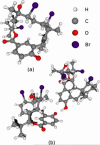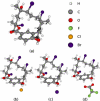Reactive desorption electrospray ionization mass spectrometry (DESI-MS) of natural products of a marine alga
- PMID: 19277616
- PMCID: PMC3375022
- DOI: 10.1007/s00216-009-2674-3
Reactive desorption electrospray ionization mass spectrometry (DESI-MS) of natural products of a marine alga
Abstract
Presented here is the optimization and development of a desorption electrospray ionization mass spectrometry (DESI-MS) method for detecting natural products on tissue surfaces. Bromophycolides are algal diterpene-benzoate macrolide natural products that have been shown to inhibit growth of the marine fungal pathogen Lindra thalassiae. As such, they have been implicated in antimicrobial chemical defense. However, the defense mechanisms are not yet completely understood. Precise detection of these compounds on algal tissue surfaces under ambient conditions without any disruptive sample processing could shed more light onto the processes involved in chemical defense of marine organisms. Conventional DESI-MS directly on algal tissue showed relatively low sensitivity for bromophycolide detection. Sensitivity was greatly improved by the addition of various anions including Cl(-), Br(-), and CF(3)COO(-) into the DESI spray solvent. Chloride adduction gave the highest sensitivity for all assayed anions. Density functional optimization of the bromophycolide anionic complexes produced during DESI supported this observation by showing that the chloride complex has the most favorable binding energy. Optimized DESI protocols allowed the direct and unambiguous detection of bromophycolides, including A, B, and E, from the surface of untreated algal tissue.
Figures







Similar articles
-
Desorption electrospray ionization mass spectrometry reveals surface-mediated antifungal chemical defense of a tropical seaweed.Proc Natl Acad Sci U S A. 2009 May 5;106(18):7314-9. doi: 10.1073/pnas.0812020106. Epub 2009 Apr 6. Proc Natl Acad Sci U S A. 2009. PMID: 19366672 Free PMC article.
-
Desorption electrospray ionization of explosives on surfaces: sensitivity and selectivity enhancement by reactive desorption electrospray ionization.Anal Chem. 2005 Nov 1;77(21):6755-64. doi: 10.1021/ac050995+. Anal Chem. 2005. PMID: 16255571
-
Desorption electrospray ionization (DESI) mass spectrometry and tandem mass spectrometry (MS/MS) of phospholipids and sphingolipids: ionization, adduct formation, and fragmentation.J Am Soc Mass Spectrom. 2008 Apr;19(4):531-43. doi: 10.1016/j.jasms.2007.12.003. Epub 2007 Dec 27. J Am Soc Mass Spectrom. 2008. PMID: 18258448
-
Imaging the Unimaginable: Desorption Electrospray Ionization - Imaging Mass Spectrometry (DESI-IMS) in Natural Product Research.Planta Med. 2018 Jul;84(9-10):584-593. doi: 10.1055/s-0044-100188. Epub 2018 Jan 31. Planta Med. 2018. PMID: 29388184 Free PMC article. Review.
-
Desorption electrospray ionization mass spectrometry for lipid characterization and biological tissue imaging.Biochim Biophys Acta. 2011 Nov;1811(11):946-60. doi: 10.1016/j.bbalip.2011.05.006. Epub 2011 May 27. Biochim Biophys Acta. 2011. PMID: 21645635 Free PMC article. Review.
Cited by
-
Mass spectral molecular networking of living microbial colonies.Proc Natl Acad Sci U S A. 2012 Jun 26;109(26):E1743-52. doi: 10.1073/pnas.1203689109. Epub 2012 May 14. Proc Natl Acad Sci U S A. 2012. PMID: 22586093 Free PMC article.
-
Addition of Serine Enhances Protein Analysis by DESI-MS.J Am Soc Mass Spectrom. 2019 Apr;30(4):694-703. doi: 10.1007/s13361-018-02129-8. Epub 2019 Feb 15. J Am Soc Mass Spectrom. 2019. PMID: 30771107
-
Streamlined Multimodal DESI and MALDI Mass Spectrometry Imaging on a Singular Dual-Source FT-ICR Mass Spectrometer.Metabolites. 2021 Apr 20;11(4):253. doi: 10.3390/metabo11040253. Metabolites. 2021. PMID: 33923908 Free PMC article.
-
Polyhydroxyanthraquinones as quorum sensing inhibitors from the guttates of Penicillium restrictum and their analysis by desorption electrospray ionization mass spectrometry.J Nat Prod. 2014 Jun 27;77(6):1351-8. doi: 10.1021/np5000704. Epub 2014 Jun 9. J Nat Prod. 2014. PMID: 24911880 Free PMC article.
-
Ambient analysis of saturated hydrocarbons using discharge-induced oxidation in desorption electrospray ionization.J Am Soc Mass Spectrom. 2010 Feb;21(2):261-7. doi: 10.1016/j.jasms.2009.10.006. Epub 2009 Nov 13. J Am Soc Mass Spectrom. 2010. PMID: 19914089
References
-
- Chen HW, Talaty NN, Takats Z, Cooks RG. Anal Chem. 2005;77:6915–6927. - PubMed
-
- Cooks RG, Ouyang Z, Takats Z, Wiseman JM. Science. 2006;311:1566–1570. - PubMed
-
- Cotte-Rodriguez I, Takats Z, Talaty N, Chen HW, Cooks RG. Anal Chem. 2005;77:6755–6764. - PubMed
-
- Nyadong L, Green MD, De Jesus VR, Newton PN, Fernandez FM. Anal Chem. 2007;79:2150–2157. - PubMed
-
- Takats Z, Cotte-Rodriguez I, Talaty N, Chen HW, Cooks RG. Chem Commun. 2005:1950–1952. - PubMed
Publication types
MeSH terms
Substances
Grants and funding
LinkOut - more resources
Full Text Sources
Other Literature Sources
Research Materials

